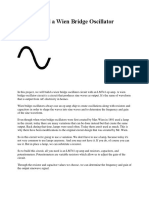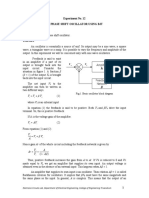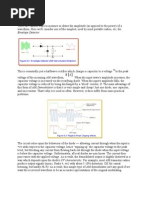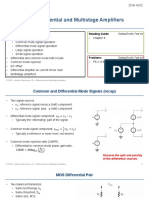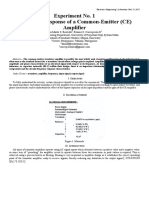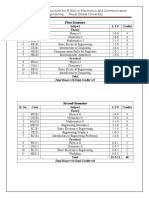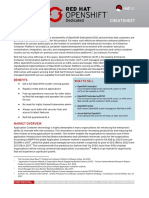High Pass
Uploaded by
Mamoon BarbhuyanHigh Pass
Uploaded by
Mamoon BarbhuyanTitle: RC high pass filter.
Aim: To design a passive high pass filter using RC components in 1 st order and to determine the cut off
frequency.
Apparatus/components used:
Name Specifications Quantity
Resistor
Capacitor
Function generator
Digital multimeter
Circuit diagram:
Fig -1: 1st order high pass filter
Theory:
A filter is a frequency selective device. Filters may be of several types. These include low pass,
high pass, band pass and band elimination filters. The high pass filters allow frequencies above the cut
off frequency to flow through it. It blocks or eliminates all frequency components below the cut-off
frequency. The cut-off frequency provides a limit to define the pass band and stop band for the filter.
Ideally, there should be a sharp demarcation between a pass band and stop band. But practically, the
demarcation is more gradual allowing the pass band to spill over to the stop band. To make the
demarcation sharp, multi order filters are designed.
A passive filter does not have any ability to amplify or actively process the signals flowing
through them. It means that they don’t use transistors, OPAMPs or any other active components. These
arte fabricated using only passive components like resistors, capacitors and inductors.
The cut-off frequency will be given by:
1
f c=
2 πRC
At cut-off frequency, the gain Av (V0/Vin) increases to 70.7% of its peak value.
Procedure:
1. Connect the circuit as shown in fig.1
2. With the help of the function generator the input of 1V, 1000 Hz is given.
3. Now change the value of the input frequencies and note down the corresponding output
voltage with the help of a digital multimeter.
4. Calculate the gain Av (V0/Vin) in each step.
5. Plot the frequency response curve of the filter taking frequency in the X- axis and gain in the Y-
axis.
Observation table:
Input voltage, Vin:…….; value of R:…….; value of C:…….;
No.of Input frequency Output Gain Cut-off frequency, fc
observation (Hz) voltage, V0
From graph From theory
Result: Cut-off frequency (experimental):
Cut- off frequency (theoretical):
Conclusion:
You might also like
- Basic Electrical Laboratory Manual: Department of Electrical EngineeringNo ratings yetBasic Electrical Laboratory Manual: Department of Electrical Engineering42 pages
- Field Effect Transistor (FET) : Electronic II Second Year, 2015-2016 Part II LecturesNo ratings yetField Effect Transistor (FET) : Electronic II Second Year, 2015-2016 Part II Lectures62 pages
- Final Year PW-1 VTU Guidelines For The Preparation of The Project ReportsNo ratings yetFinal Year PW-1 VTU Guidelines For The Preparation of The Project Reports7 pages
- 1918779744-Measurement of Earth Resistance Using MeggerNo ratings yet1918779744-Measurement of Earth Resistance Using Megger3 pages
- How To Build A Wien Bridge Oscillator CircuitNo ratings yetHow To Build A Wien Bridge Oscillator Circuit5 pages
- MATLAB SIMULINK File Power Electronic Ci PDFNo ratings yetMATLAB SIMULINK File Power Electronic Ci PDF29 pages
- 11-THREE PORT DEVICES E H MAGIC TEE-02-Aug-2019Material - I - 02-Aug-2019 - Prabhu-Tee - E - H - Magic - Tee - S - MatrixNo ratings yet11-THREE PORT DEVICES E H MAGIC TEE-02-Aug-2019Material - I - 02-Aug-2019 - Prabhu-Tee - E - H - Magic - Tee - S - Matrix77 pages
- Steady-State Equivalent Circuit Modeling, Losses, and EfficiencyNo ratings yetSteady-State Equivalent Circuit Modeling, Losses, and Efficiency20 pages
- Configuring Instrumentation and Control DevicesNo ratings yetConfiguring Instrumentation and Control Devices30 pages
- F9 - Differential and Multistage Amplifiers: Reading Guide OutlineNo ratings yetF9 - Differential and Multistage Amplifiers: Reading Guide Outline23 pages
- Loading Effects and Two-Port Networks Week 5 - 6No ratings yetLoading Effects and Two-Port Networks Week 5 - 631 pages
- Experiment No: 01 Voltage Controlled OscillatorNo ratings yetExperiment No: 01 Voltage Controlled Oscillator7 pages
- Experiment No. 1 Frequency Response of A Common-Emitter (CE) AmplifierNo ratings yetExperiment No. 1 Frequency Response of A Common-Emitter (CE) Amplifier6 pages
- Experiment 7 Three Phase Star and Delta Connected System Aim100% (1)Experiment 7 Three Phase Star and Delta Connected System Aim3 pages
- E. Ambikairajah Australia: Part A: Signal ProcessingNo ratings yetE. Ambikairajah Australia: Part A: Signal Processing152 pages
- Health Monitoring System Using 7-Segment Display & Atmega MicrocontrollerNo ratings yetHealth Monitoring System Using 7-Segment Display & Atmega Microcontroller5 pages
- Chapter Three Op-Amp Characteristics and Applications: + Non-Inverting OutputNo ratings yetChapter Three Op-Amp Characteristics and Applications: + Non-Inverting Output17 pages
- Department of Electronics & Telecommunication: Presented By: Valluri Bhavana MSC - Etc, 1 Semester Roll No: Pg19Etc-002No ratings yetDepartment of Electronics & Telecommunication: Presented By: Valluri Bhavana MSC - Etc, 1 Semester Roll No: Pg19Etc-00222 pages
- Experiment 1: Response Characteristics of Thermocouples: ObjectiveNo ratings yetExperiment 1: Response Characteristics of Thermocouples: Objective4 pages
- Simulation of Some Power System, Control System and Power Electronics Case Studies Using Matlab and PowerWorld SimulatorFrom EverandSimulation of Some Power System, Control System and Power Electronics Case Studies Using Matlab and PowerWorld SimulatorNo ratings yet
- Q. 1 - Q. 5 Carry One Mark Each.: GATE 2019 General Aptitude (GA) Set-1No ratings yetQ. 1 - Q. 5 Carry One Mark Each.: GATE 2019 General Aptitude (GA) Set-128 pages
- Mohanty IEEE CEM 2016 Apr WSN SimulationNo ratings yetMohanty IEEE CEM 2016 Apr WSN Simulation8 pages
- Appendix A: Error Probability in The Transmission of Digital SignalsNo ratings yetAppendix A: Error Probability in The Transmission of Digital Signals11 pages
- Ece 465 Introduction To Cplds and Fpgas: Shantanu Dutt Ece Dept. University of Illinois at ChicagoNo ratings yetEce 465 Introduction To Cplds and Fpgas: Shantanu Dutt Ece Dept. University of Illinois at Chicago11 pages
- 1 Semester: Break Up of BE Course StructureNo ratings yet1 Semester: Break Up of BE Course Structure8 pages
- Instant Download Digital Logic Design Devices and circuits by Gamal El Sheikh 9ed 9th Edition Gamal El-Sheikh PDF All Chapters100% (1)Instant Download Digital Logic Design Devices and circuits by Gamal El Sheikh 9ed 9th Edition Gamal El-Sheikh PDF All Chapters40 pages
- Instruction Set and Assembler DirectivesNo ratings yetInstruction Set and Assembler Directives19 pages
- An5525 St8500 Power Line Communication Systemonchip g3plc Characterization StmicroelectronicsNo ratings yetAn5525 St8500 Power Line Communication Systemonchip g3plc Characterization Stmicroelectronics41 pages
- Elonics E4000 Low Power CMOS Multi Band Tuner DatasheetNo ratings yetElonics E4000 Low Power CMOS Multi Band Tuner Datasheet59 pages
- PQube 3 Power Analyzer Data Sheet.V3 - enNo ratings yetPQube 3 Power Analyzer Data Sheet.V3 - en4 pages
- Description: Confidential - Red Hat Associate and Nda Partner Use Only - No Further DistributionNo ratings yetDescription: Confidential - Red Hat Associate and Nda Partner Use Only - No Further Distribution6 pages
- Brinkmann: Manual For Integrated AmplifierNo ratings yetBrinkmann: Manual For Integrated Amplifier4 pages
- Veritas Netbackup ™ Enterprise Server and Server 8.0 - 8.X.X Os Software Compatibility ListNo ratings yetVeritas Netbackup ™ Enterprise Server and Server 8.0 - 8.X.X Os Software Compatibility List84 pages
- 3.2.2.4 Packet Tracer - Configuring Trunks Instructions IGNo ratings yet3.2.2.4 Packet Tracer - Configuring Trunks Instructions IG3 pages
- PVP7 Standard Firmware Upgrade Package 15.00-20240927 Release NotesNo ratings yetPVP7 Standard Firmware Upgrade Package 15.00-20240927 Release Notes5 pages

























